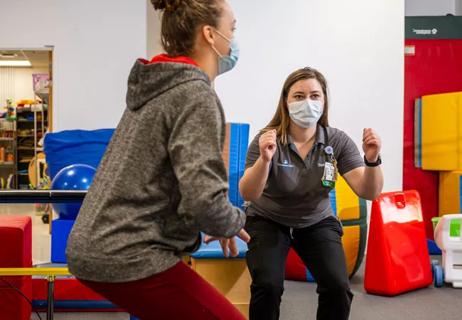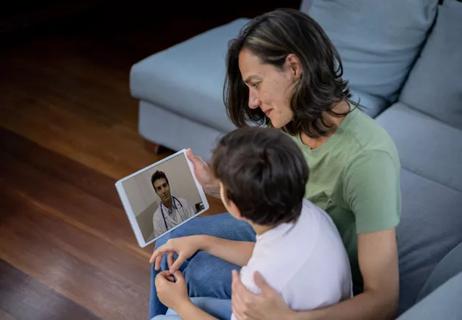Team-based approach helps patients and families

Some estimates have suggested about 121,000 of approximately 2.8 million wheelchair users in the United States are children, although these numbers are difficult to confirm.
Cleveland Clinic is a non-profit academic medical center. Advertising on our site helps support our mission. We do not endorse non-Cleveland Clinic products or services. Policy
Lainie Holman, MD, Chair of Pediatric Physical Medicine and Rehabilitation (CCCHR) and the rest of the team in the Mobility and Seating Clinic work closely with children and their families to design custom mobility solutions.
A physical therapist, physician and rehabilitation aide work with the patient to assess mobility and positioning, provide education related to equipment options, and identify patient- and family-specific needs.
“Our goal is really to advocate for the patient and prevent supplier-led decisions about equipment. Insurance constraints mean there is a five-year commitment to the frame itself,” explains Dr. Holman. “Children grow and change quickly, and five years is a long time in that regard, so we aim to best support the child and family, while also working closely with the vendor,” she says.
The seating, brakes, and wheels can be changed during that five-year period, but a new frame can be a sizeable out-of-pocket expense. The frame must be carefully selected based on anticipated growth and change in the child’s condition, but also based on what the family can manage.
Infrastructure for a power chair, as an example, can be limiting. The family may not have a van or a wheelchair ramp for the patient to easily enter and exit the home. Other considerations may include convenience versus functionality. For example, a patient may be attracted to a folding frame for convenience, but a rigid frame is often a better alternative because it has fewer moving parts and, therefore, less potential for malfunction. It’s also a smoother ride.
This is just the beginning. Once they decide on a frame, they must then choose every other detail on the chair separately. Each element, including the armrest, footrest, wheels, castors, push handles, cushion, and back, is a line item – all custom-ordered for the child.
It needs to be done systematically, explains Dr. Holman. “For example, you might want short armrests for a smaller child who’s going to pull up to a table in, say, first grade, or you might want longer armrests for a child who’s going to use a tray on their wheelchair to do their work.”
In a recent case, Dr. Holman and her team guided a 2-year-old child, with no motor function of the bilateral lower extremities, and his family through the process. The child, who mostly arm crawls at home, also has some instability in forward trunk flexion. He was born prematurely at 27 weeks of gestation following prenatal repair of myelomeningocele at 25 weeks and has a ventriculoperitoneal (VP) shunt.
Considerations for equipment included weight, growth, lack of sensation, family transportation, school transportation, and postural support.
“We ultimately recommended a manual wheelchair with customized features, including a butterfly-style chest harness, single-stroller handle, pelvic belt, embrace cushion seat and comfortable, contoured backrest— and he loved it!”
A 17-year-old was referred to the Seating and Mobility Clinic after an initial evaluation following a spinal cord injury. She received an ultralight manual wheelchair while in rehab, but once she returned to cosmetology school, she was unable to perform certain tasks in the wheelchair. The team helped her explore standing power mobility options, and she ultimately selected power standing equipment that afforded her increased independence and mobility in the salon, at home, and in activities of daily living.
“Power standing is more difficult to get through insurance, so it’s definitely better if people who need a standing feature come to the Seating and Mobility Clinic because we facilitate all the justification for it,” says Dr. Holman.
While the technology for wheeled mobility continues to evolve, insurance reimbursements can make it difficult for patients to obtain equipment that might best support their quality of life.
Newer models continue to utilize innovative technology, such as eye gaze software, standing features, and sensory safety equipment, like crowd control features. Other models are being developed for stair-climbing and off-roading, but are not yet FDA-approved and, therefore, aren’t covered by insurance.
“We can do everything from a very simple manual chair or an adaptive sports chair to a very complicated, electronically driven chair with head array or eye gaze technology — and everything in between,” concludes Dr. Holman. “Really, I would prefer that every kid, and even every adult, in Northeast Ohio who needs a wheelchair would come to our Mobility and Seating Clinic.”

Self-efficacy mindset, burst therapy and increased biofeedback may help improve outcomes

6 objective measures to assess pain and evaluate progress

Recognizing mobility as a human right is instrumental to change

A closer look at select programs and services

Physicians in the field should tout an array of accomplishments to achieve well-deserved recognition

How lyric writing, song production is helping patients ‘reclaim their power’

Barriers to access and innovations on the horizon